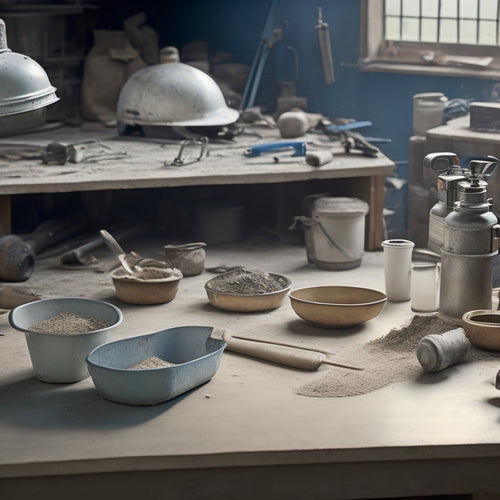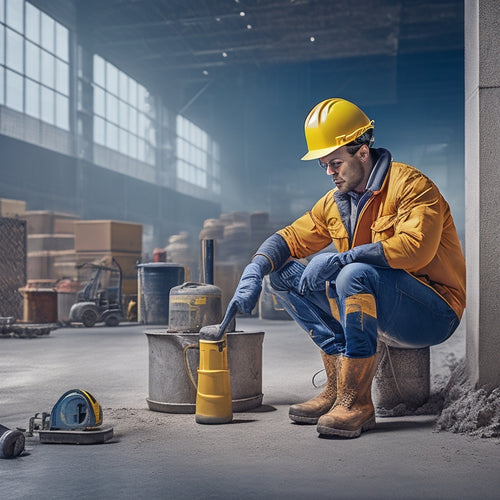
3 Best Tools for Laying Concrete Blocks Perfectly
Share
You'll need a combination of specialized tools to lay concrete blocks perfectly. For tamping, opt for a hand tamper for small areas, a plate compactor for larger ones, and a jumping jack tamper for challenging conditions. For leveling and aligning, invest in high-quality leveling equipment, such as spirit levels or laser levels, and utilize a plumb line and straightedge to guarantee accurate alignment. Finally, for a smooth finish, use a darby or trowel to fill gaps and a finishing trowel to apply mortar or joint compound. With these essential tools, you'll be well on your way to laying concrete blocks with precision and confidence - and there's more to explore to guarantee a truly flawless finish.
Key Takeaways
• Invest in a hand tamper, plate compactor, and jumping jack tamper for effective soil stabilization and compacting.
• Use high-quality leveling equipment, such as spirit levels or laser levels, for accurate alignment of blocks.
• Employ a darby or trowel to fill gaps between blocks and create a solid foundation for finishing.
• Apply a thin layer of mortar or joint compound with a finishing trowel, feathering it out towards edges for a seamless joint.
• Utilize a combination of essential tamping tools and techniques to achieve a durable and perfectly laid concrete block structure.
Essential Tamping Tool Options
You'll need three essential tamping tool options in your arsenal to guarantee a solid foundation and prevent settling or shifting of the concrete blocks. These tools will help you master various tamping techniques, ensuring a sturdy base for your structure.
First, invest in a hand tamper, typically made from durable tool materials like steel or aluminum. This versatile tool is perfect for compacting small areas and getting into tight spaces.
Next, add a plate compactor to your collection, which is ideal for larger areas and provides more forceful compacting.
Finally, consider a jumping jack tamper, a specialized tool designed for compacting soil and aggregate materials.
When choosing your tamping tools, look for high-quality materials that can withstand the rigors of construction.
By having these three essential tools at your disposal, you'll be well-equipped to tackle any concrete block laying project with confidence.
With the right tools and techniques, you'll achieve a solid foundation that will last for years to come.
Leveling and Aligning Made Easy
To guarantee your concrete block structure is built to last, accurately leveling and aligning each course is essential, and the right tools can make this critical step a whole lot easier.
You'll want to invest in high-quality leveling equipment types, such as spirit levels, laser levels, or digital levels, to ascertain your blocks are perfectly aligned. These tools will help you detect even the slightest deviations from the desired plane, allowing you to make precise adjustments as needed.
When it comes to block alignment techniques, you'll want to focus on achieving a consistent, plumb line. This can be achieved by using a string line and a level to establish a reference point, and then using a straightedge or a block alignment tool to ensure each course is properly aligned.
Smoothing Out the Finish
With your blocks accurately aligned and leveled, it's time to focus on achieving a smooth, even finish by applying the right techniques and tools to eliminate any imperfections.
To attain a flawless finish, you'll need to employ effective finishing techniques. Start by using a darby or trowel to fill in any gaps or voids between the blocks. This will create a solid foundation for your finish. Next, use a finishing trowel to apply a thin layer of mortar or joint compound, feathering it out towards the edges. This will help to create a seamless joint.
Proper surface preparation is key to a successful finish. Make sure to remove any excess mortar or debris from the surface of the blocks before applying your finish. Use a wire brush or broom to clean the surface, and then apply a bonding agent to guarantee a strong bond between the blocks and your finish.
Frequently Asked Questions
How Do I Prevent Concrete Blocks From Shifting During Construction?
When building with concrete blocks, you'll want to guarantee they don't shift during construction.
To achieve this, focus on block stability techniques from the get-go. Start by preparing the construction site properly, making sure the ground is level, compacted, and clean.
Lay a solid foundation by installing a sturdy base course, and then use a spirit level to check the blocks' alignment as you go.
This attention to detail will give you a stable structure that'll last.
What Safety Gear Is Necessary When Laying Concrete Blocks?
When laying concrete blocks, you're not just building a structure, you're ensuring your own safety.
You'll need the right protective equipment to comply with safety regulations. Invest in a pair of durable gloves, safety glasses, and a dust mask to protect yourself from debris and airborne particles.
Don't forget steel-toed boots and a hard hat to prevent head and foot injuries.
Can I Reuse Concrete Block Laying Tools for Other Projects?
'Oh, you think you can just reuse those concrete block laying tools for your next DIY project, huh? Think again!
Those trowels, levels, and jointers need TLC (tender loving care) to guarantee they're in top shape for the next gig. Proper tool maintenance is key to extending their lifespan.
But, yes, with a little TLC, you can reuse them for other projects, leveraging their versatility.
Just remember, a well-maintained tool is a happy tool, and a happy tool is a productive one!'
How Do I Ensure Accurate Block Spacing and Alignment?
To guarantee accurate block spacing and alignment, you'll want to master block layout techniques.
Start by establishing a reference line, then use alignment tools like a spirit level, string lines, and a story pole to guide your block placement.
Double-check your work with a precision measuring tape to maintain uniform spacing.
What Are Some Common Mistakes to Avoid When Laying Concrete Blocks?
Imagine a puzzle with missing pieces - that's what your concrete block project can become if you don't avoid common mistakes.
You'll want to steer clear of uneven block placement techniques, which can lead to a structurally unsound wall.
Don't fall into the trap of misaligned blocks, incorrect mortar application, or insufficient curing times.
Recognize and correct these common block errors to guarantee a sturdy, professional-looking finish that'll make you proud.
Conclusion
As you put the finishing touches on your concrete block masterpiece, you can step back and admire the fruits of your labor.
With the right tools in your arsenal, the once-daunting task of laying concrete blocks has transformed into a symphony of precision and control.
The tamping tool's rhythmic thuds, the level's steady gaze, and the trowel's gentle caress have harmonized to create a solid foundation that will stand the test of time.
Related Posts
-

What Tools Do You Need for Concrete Success
For concrete success, you'll need a range of essential power tools, including rotary hammers, angle grinders, concret...
-

10 Best Tools for Sealed Concrete Flooring on Budget
When starting on a sealed concrete flooring project on a budget, you'll need to prioritize essential tools without sa...
-

Top Tools for Concrete Repair Success
When it comes to concrete repair success, you'll need a well-stocked toolkit with essential hand tools like trowels, ...


